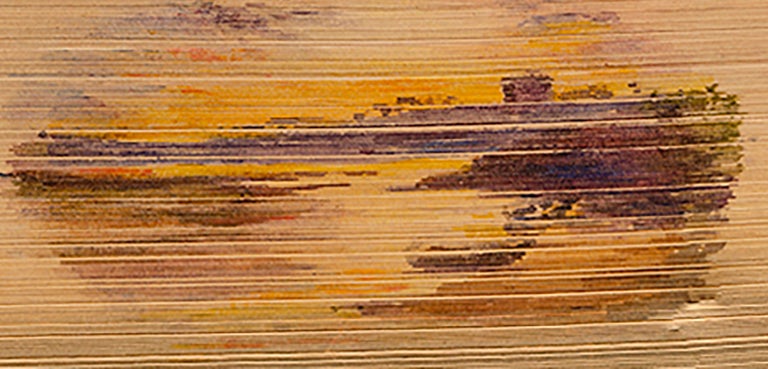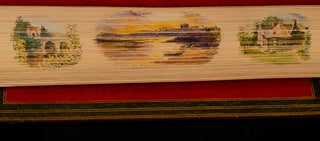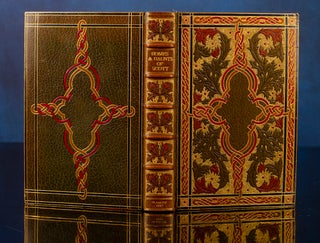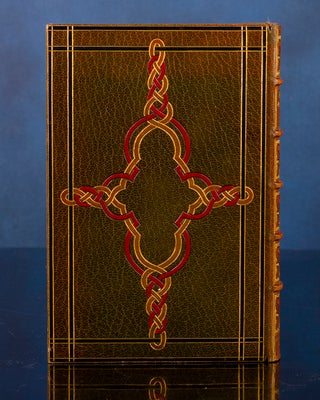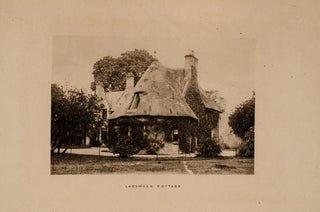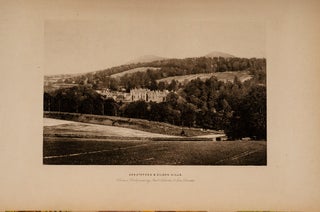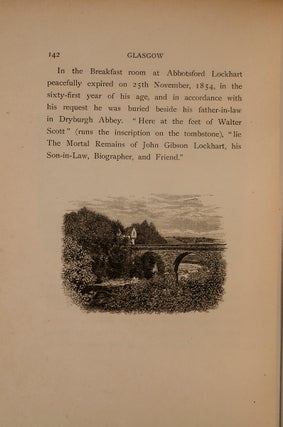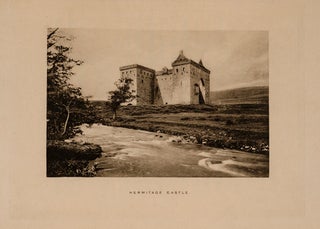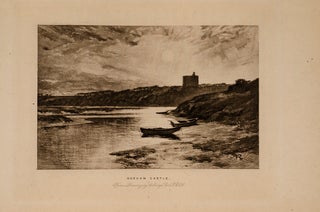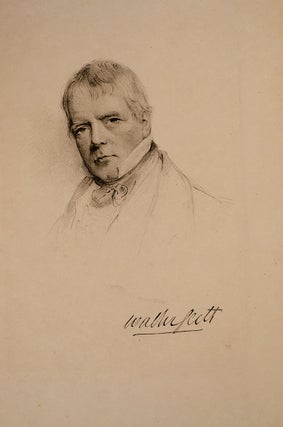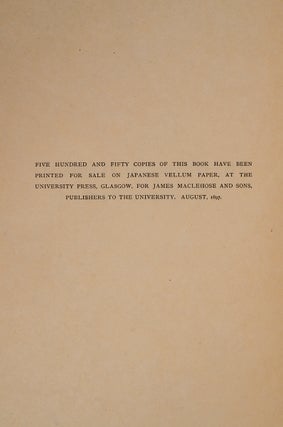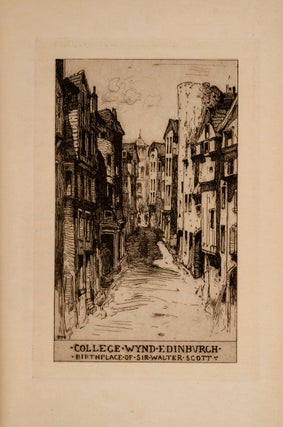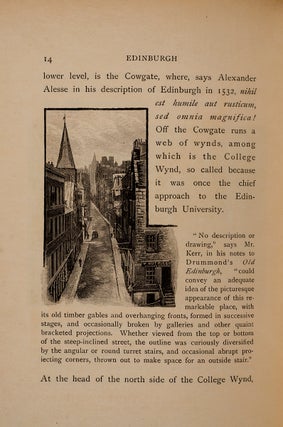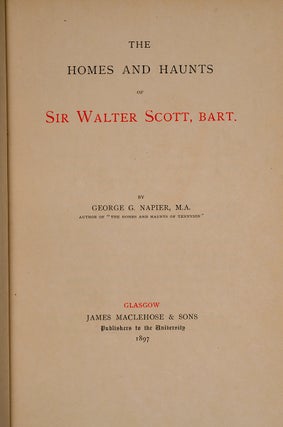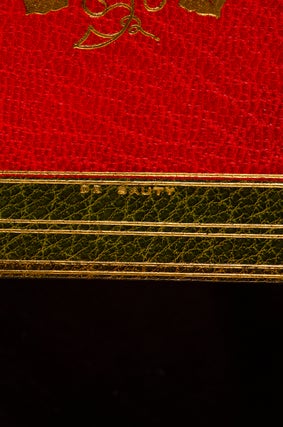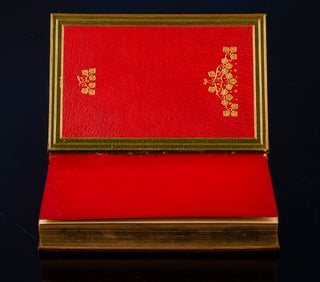Homes and Haunts of Sir Walter Scott, Bart., The
Glasgow: James Maclehose, 1897. Item #05157
A Spectacular Alfred de Sauty Inlaid Binding with a Triptych Fore-Edge Painting
FORE-EDGE PAINTING. DE SAUTY, Alfred, binder & artist. NAPIER, George G. The Homes and Haunts of Sir Walter Scott, Bart. Glasgow: James Maclehose, 1897.
A Superb Alfred De Sauty Arts and Crafts Binding with a fine Triptych Fore-Edge Painting depicting three scenes from the text.
Limited to 550 copies printed on Japanese vellum paper.
Octavo (8 3/4 x 5 7/8 inches; 222 x 149 mm.). [i]-xiv, [2, map, verso blank], [1]-216 pp. Twenty-four fine photogravure plates and seventy-two engravings in the text. Title-page printed in red and black.
Bound ca. 1905 by Alfred De Sauty, stamped in gilt on front turn-in. Contemporary full green levant morocco, front cover elaborately decorated in gilt pointille and inlaid with Celtic strapwork and floral patterns in red, brown and dark blue morocco's. Rear cover decoratively ruled in gilt with a central strapwork of red, brown and dark blue morocco's.
Spine with five raised bands elaborately decorated in gilt pointille and inlaid red morocco flowers. Gilt ruled board edges and turn-ins, red morocco doublures and endleaves, the doublures decorated with flowers in gilt, all edges gilt.
Spine very slightly faded, front joint expertly and almost invisibly repaired. Housed in a felt-lined red cloth clamshell case, spine with leather label, lettered in gilt. A spectacular example - somewhat typical of the great Rivière bindings of 1905-1920 with the finest gilt pointille work.
The triptych fore-edge painting depicts three scenes from the text:
1. "The Entrance to Milton Lockhart" (page 142)
2. "Norham Castle (page 24)
3. "Lasswade Cottage" (page 33)
"It is possible that a triptych painting is one element suggestive of a De Sauty fore-edge painting. At the Pierpont Morgan Library, is a specimen with such an edge decoration: I. Walton, Complete Angler, London, 1844, with edges gauffered and with a fore-edge painting on the closed edge "displaying three views in water colors within.".… Another similar treatment was found on a piece owned by Ziern-Hanon Galleries, St. Louis, Missouri. This item appeared for sale in 2009: George G. Napier, The Haunts and Homes of Sir Walter Scott, Glasgow: James Maclehose & Sons, 1897, with an inlaid full green morocco, extra gilt, a.e.g., and the edges with three vignettes of rural scenes on the fore-edge. The binding is decorated with a Celtic knot motif, with raised bands and flower and leaf design in each compartment. The binding is signed on the leather front doublure. Even though the fore-edges are not signed, no other person but the binder would have added paintings on the fore-edge of a special binding." (Weber. Annotated Dictionary, De Sauty 2. p. 91 - with color photograph).
Alfred de Sauty (1870-1949) was a bookbinder who produced tooled bindings of exceptional delicacy. De Sauty was active in London from approximately 1898 to 1923 and in Chicago from 1923 to 1935. His finest work is thought to be have been accomplished between 1905 and 1914. Many aspects of his life are poorly documented. For instance, scholars are unsure whether, when in London, de Sauty worked independently, for the firm of Rivière & Sons, or both. While in London, he may also have been a designer for the Hampstead Bindery and a teacher at the Central School of Arts and Crafts. When he lived in Chicago, de Sauty worked for the hand bindery of R. R. Donnelley & Sons. He signed his work at the foot of the front doublure, if present, and at the center of the bottom turn-in of the front upper board, if not. Works he produced in London are signed "de S" or "De Sauty." Works he produced in Chicago are signed with his employer's name, 'R. R. Donnelly'" (Bound in Intrigue, Harvard Botany Libraries Online Exhibit)
From 1921 to 1981, R.R. Donnelley operated a hand bindery, one of the few printing companies in the United States to do so. Commissions for one-of-a-kind bindings came from important collectors, universities, corporations, and libraries throughout the country. The Donnelley management recognized that the Extra Bindery, as it was called, while not really a profit center, underscored for other sections of the company the importance of fine craftsmanship as exemplified by an age-old craft. For thirteen years, the Extra Bindery was headed by the distinguished English bookbinder Alfred de Sauty, who was recruited by T. E. Donnelley from the Central School of Arts and Crafts in London. De Sauty immediately set the standard for American bookbinding when he hired three European-trained bookbinders, William Anson, Basil Cronk, and Leonard Mounteney. As was the European tradition, hand-binding at Donnelley was a team effort. The head of the bindery generally established the design and specified the materials. From there, a book passed through the hands of several staff members, each responsible for a particular aspect of the process; sewing, backing, tooling, and finishing. Donnelley promoted hand-binding by hosting exhibitions on the subject and by publishing a number of notable books, including Extra Binding at the Lakeside Press (1925). When de Sauty retired in 1935, Harold Tribolet, who began as an apprentice with Donnelley in 1927, became the head of the Extra Bindery.
"It has been my delight and privilege to make frequent 'raids' into Scott's country, and to study and photograph the localities rendered classic by his genius." (George G. Napier - preface). Provenance: Ziern-Hanon Galleries, Missouri (2009); Weber. Annotated Dictionary, De Sauty 2. (2010).
Price: $7,500.00

 I have been in the rare and antiquarian book business for over forty years; my family has been in the rare books business since 1876. Rare books are in my blood.
I have been in the rare and antiquarian book business for over forty years; my family has been in the rare books business since 1876. Rare books are in my blood.
